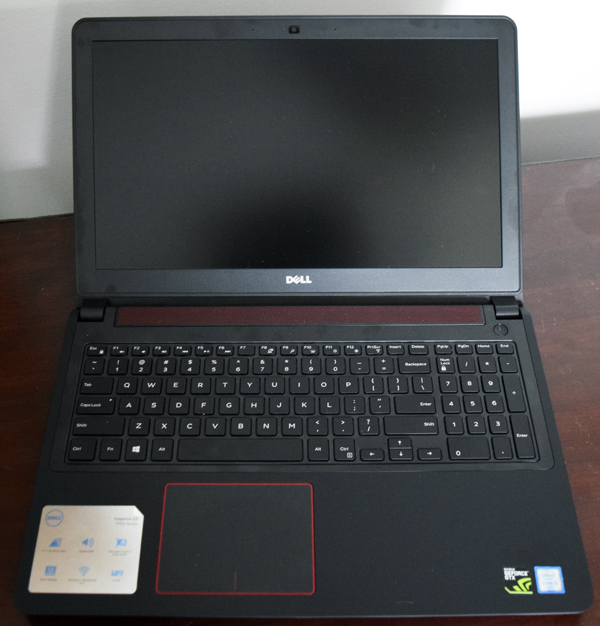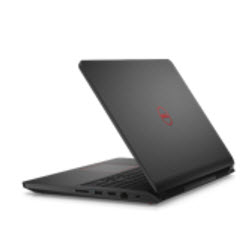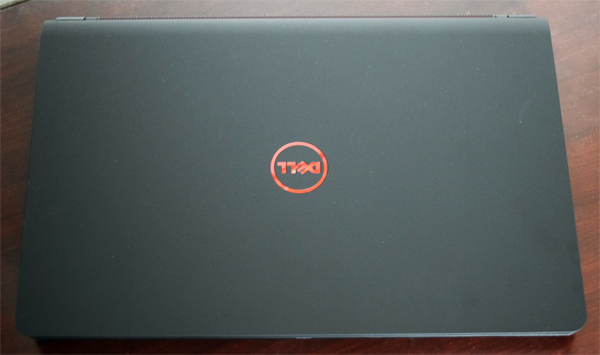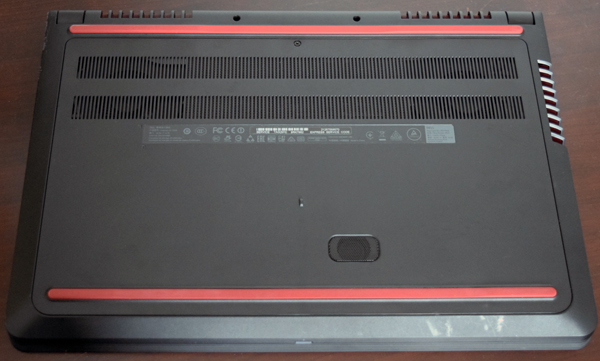Dell Inspiron 15 7559 $800 Gaming Laptop First Look
The Dell Inspiron 15 7559 is a budget-oriented laptop aimed at gamers who want to play the latest titles on the go. Let's see what this sub-$800 system can do.
Hands-On And First Impressions
[Editor's Note: The following content is intended to be a first look, with some hands-on impressions and a few benchmarks. We will be conducting full reviews of gaming laptops soon enough, with a battery of exhaustive tests, including more thorough benchmarks (we're currently revamping our benchmark suite), and deeper analysis. But we wanted to get some of the newer models into the lab for some early testing.]
The Dell Inspiron 15 7559 is a budget system that is primarily black, but has red highlights in several sections including the touchpad, speaker, fans, the rubber pads on the bottom of the system and the Dell emblem emblazoned on the back.
Like most laptops, the bottom of the chassis has a panel that can be removed, giving you access to some parts of the system's hardware. Dell clearly designed this laptop to be easy for enthusiasts to work on and upgrade. There is only one screw holding the panel in place, and after removing it, you can get to the hard drive, RAM, Wi-Fi card, battery, two fans and an M.2 slot, all of which are replaceable. A few additional screws hold the fans in place, but after unscrewing them, the fans slide out of place with little effort, making it easy to blow dust out. Unless a major piece of hardware fails, you won't find many reasons to dig any deeper into the Inspiron's guts.
Specifications
MORE: All Laptops Articles
MORE: Laptops in the Forums
Dell's Inspiron 15 comes loaded with an almost clean installation of Windows 10 Home. Looking through its drive, the most troublesome find was a trial of McAfee LiveSafe, which only took a moment to uninstall.
The internal hardware is fairly high-performance for an $800 system. You don't get Hyper-Threading technology, but unlike most mobile Core i5s, there are four physical execution cores capable of frequencies as high as 3.2GHz. Because Dell's machine employs a 5400 RPM SSHD for storage, games are loaded noticeably slower than competing platforms with SSDs. Fortunately, it boots fairly quickly. And because the M.2 slot is easily accessible, enthusiasts concerned about not having an SSD can simply install one.
The laptop is a little heavy, weighing roughly 5.67 pounds. As such, it's a bit painful to carry around all day. This isn't the system I'd choose if I knew I'd be walking around with it a lot. Still, it's lighter than many of the gaming laptops we have in the lab, and it didn't bother me to lug it around for short stints. Any longer than an hour, though, and the weight did start hurting my shoulder. In comparison, when I carried Lenovo's Ideapad 100S, which is only about 2.2 pounds, it was much more comfortable to haul for long periods of time.
Get Tom's Hardware's best news and in-depth reviews, straight to your inbox.
The laptop's hinges are rather stiff. I'm sure that many of you own notebooks with weak hinges, where the display wobbles a bit when you use it in a plane or car. This system doesn't do that. I went so far as to shake it around a bit, and the display stayed in place.
The Inspiron's 2.1-channel audio setup is decent. The left and right speakers are placed directly in front of the display, while bass comes from a small driver in the base. While listening to music, lower frequencies were more apparent than I would have expected, and if you have the system sitting on your lap, you'll feel it go off. The left and right speakers sounded a little distant at times, but still did their job well enough. With the volume turned up all the way, they get rather loud without significant distortion. Naturally, I prefer a decent gaming headset, but listening to music or movies played over the Inspiron 15's speakers is still enjoyable.
Display
The Inspiron 15 7559 I tested came with a 1920x1080 IPS anti-glare display. Dell offers a less expensive configuration with a 1366x768 panel and a higher-end model with a 4K resolution, but I specifically asked for the popular FHD screen to complement the GeForce GTX 960M inside. Nvidia's GPU is paired to 4GB of GDDR5 memory, which could be enough for 4K gaming. But with only 640 CUDA cores and a 128-bit aggregate interface, the GM107 isn't suited to anything higher than 1920x1080.
Examining the display from all sides, I didn't notice any viewing angle issues or light bleeding effects.
Input Devices
Dell's Inspiron 15 7559 has a back-lit keyboard with white LEDs. The F10 button also controls the lighting, which can be switched between a bright setting, a more muted mode and off altogether. Although the keyboard doesn't have any obvious issues, typing on it isn't as pleasant as what I'm used to on my desktop. If anything, though, the soft key presses are easier on my finger tips.
The touchpad is made of a hard plastic material with a semi-rough surface. Frankly, it's the worst part of this system. It always responded sluggishly, forcing me to make multiple swipes across the touchpad to get from one side of the screen to the other. I turned mouse acceleration up, which helped. But it still wasn't ideal. Use a USB-attached mouse instead, if you can.
Battery
Dell's spec sheet claims an exaggerated battery life of 11 hours with a similar configuration using only 4GB of RAM, or up to 7 hours and 41 minutes with 8GB of RAM, a faster Core i7 processor and a 4K panel. I found the battery life to be significantly less than that though, averaging about six hours, at best, when I only used the machine for basic Web browsing and word processing.
To be honest, I actually expected less battery life, as gaming notebooks with discrete GPUs typically gobble up power in greater quantities. But offering six hours of battery life and less weight than most competing gaming laptops makes this system more useful as a productivity-oriented platform as well.
-
dstarr3 I might just have to pick this up. I love the M.2 slot, so that you can have an OS SSD and then put a storage hard drive in it as well. That's not something you see a lot in this price range.Reply -
xenol The only worrisome thing is how hot the keyboard area gets when running a game. But I'm sure it's a lot better than the XPS 15.Reply
I'm almost tempted to get one myself.
EDIT: Notebookcheck reported the WASD area at about 41C under max load. That doesn't seem too bad. -
IInuyasha74 Reply17426197 said:The only worrisome thing is how hot the keyboard area gets when running a game. But I'm sure it's a lot better than the XPS 15.
I'm almost tempted to get one myself.
EDIT: Notebookcheck reported the WASD area at about 41C under max load. That doesn't seem too bad.
I didn't go out of my way to test this, but from general use of the laptop while playing a few games on it, I did notice the keyboard getting a little warm. It wasn't too bad. Honestly, because the room was cold it was actually rather comfortable. Again though, take this with a grain of salt as I didn't do any measurements or do any specific tests to check the heat of the keyboard during game play, just an observation. -
James Mason I own this laptop. When i bought it for $760, it came with a 256mb m.2 SSD. It does run just about every game pretty well, good enough to satisfy a mobile gaming need. It runs some games at pretty high settings as well. For $750-800 it's a pretty good investment when you consider it's basically a $500 computer with a 1080p IPS monitor and keyboard included.Reply
I use it mostly in bed, and it doesn't ever get painfully hot, but it does get pretty warm. I'd recommend buying a laptop stand for it either way to facilitate good airflow because it's vents are on the bottom. -
DouglasThurman So I read the review of this laptop from Linus Tech Tips on YouTube, and the thing that might be an issue here for these benchmarks is the single 8GB SODIMM that comes with it. That would put it in single-channel mode which sucks. If you were to slap in another 8GB chip I'm sure the scores would be faster.Reply -
Chayan4400 ReplySo I read the review of this laptop from Linus Tech Tips on YouTube, and the thing that might be an issue here for these benchmarks is the single 8GB SODIMM that comes with it. That would put it in single-channel mode which sucks. If you were to slap in another 8GB chip I'm sure the scores would be faster.
Doubt it. We regularly use single channel RAM for PC builds, and it's proven that unless you're running on the iGPU single vs dual channel has little to no effect on game's perfromance.
-
I Hate Nvidia Am currently typing this replay from the reviewed laptop , I bought the configuration with 4K touch screen and Core I5 , 1 TB SSHD , Matt black featuring grey finish:Reply
For more than a month now, this Laptop proved to worth the money I paid ( 965$ from Amazon), still there are some serious problems need to be addressed:
1- the Audio has a huge driver-hardware problem, at times there is noticeable and really annoying interference sound, it is specially noticeable with high bass levels, I thought the speakers were flawed , but using my Philips headphones n this terrible sound still there!
2- Every single owner of this laptop complains from the same ( Intel HD Graphics 8 driver Has been crashed and recovered) , this happens a lot , alottt , and it can really get annoying during gaming as it suddenly makes the game unplayable ( MGS V Phantom Pain , SC2: Legacy of the Void , AoE : Casatle Siege) , so you might need to restart the PC when this happens , or disable the Intel HD graphics altogether and risk losing battery life!
3- 4K only problem : Scaling , Scaling , Oh God MS! Scaling!!!!!! please???? and not only things get really small, performance takes a huge hit, for unknown reason!
4- 4K looks amazing , and it worth every penny of the extra 170$ I paid , but I hoped for a deeper black and better contrast, still it is really bright and color are amazing.
5- Battery life is much less than expected, almost 3.40 hours on medium backlighting , no Wi-Fi ( Airplane mode), hoped for almost 6 hours, but I guess the 4K panel is to blame for the short battery life.
All in all, this a solid performing - budget gaming laptop, MGS V = 1080 P all maxed out and smooth gaming , Legacy of the void = 1440P all maxed out and smooth gaming, add an extra 265 GB M.2 for 120$ and an extra 8 GB for 30$ and you will end with a beats machine for the money,the Keyboard experience needs some time to get used to, but it is not bad at all (Coming from an amazing Lenovo Keyboard, so everything seems less than acceptable at first), touch pad is rough, it is sensitive but rough and alson needs some time , like 3 days, to get used to, but it is not bad at all, gestures work perfectly, but I have a Touch Panel, so yeah , I paid extra for it and I should use it :) , other than that, it needs some drivers attention from Dell to end as a real competitor for much more expensive machines.
-
cub_fanatic Finally. This is what I have been wanting from Intel for years. I have always wondered why Intel didn't have a mobile quad core i5. They must have realized since the first core i5 quad core, no HT CPU that that configuration was what most mid-range gamers wanted. Before this, your only choices were a dual core, 4 thread i5 that turbo boosted. The only difference between that and the mobile i3 of the same base clock was the turbo boost. The only way you got 4 physical cores was a high end i7. Even the next step up from a mobile i5 was a dual core mobile i7 that really was just a slightly higher clocked version of the best mobile i5. This fills a gap that I can't believe took this long to fill. The last quad core, no HT mobile CPU that Intel had before this was a Core 2 Quad gen. chip from around 2008. Technically, Intel has had very low TDP quad core mobile chips in very low end laptops like the Atom and Bay Trail SoCs. But, those are nowhere near gaming chips like this i5 is.Reply -
IInuyasha74 Reply17427203 said:Am currently typing this replay from the reviewed laptop , I bought the configuration with 4K touch screen and Core I5 , 1 TB SSHD , Matt black featuring grey finish:
For more than a month now, this Laptop proved to worth the money I paid ( 965$ from Amazon), still there are some serious problems need to be addressed:
1- the Audio has a huge driver-hardware problem, at times there is noticeable and really annoying interference sound, it is specially noticeable with high bass levels, I thought the speakers were flawed , but using my Philips headphones n this terrible sound still there!
2- Every single owner of this laptop complains from the same ( Intel HD Graphics 8 driver Has been crashed and recovered) , this happens a lot , alottt , and it can really get annoying during gaming as it suddenly makes the game unplayable ( MGS V Phantom Pain , SC2: Legacy of the Void , AoE : Casatle Siege) , so you might need to restart the PC when this happens , or disable the Intel HD graphics altogether and risk losing battery life!
3- 4K only problem : Scaling , Scaling , Oh God MS! Scaling!!!!!! please???? and not only things get really small, performance takes a huge hit, for unknown reason!
4- 4K looks amazing , and it worth every penny of the extra 170$ I paid , but I hoped for a deeper black and better contrast, still it is really bright and color are amazing.
5- Battery life is much less than expected, almost 3.40 hours on medium backlighting , no Wi-Fi ( Airplane mode), hoped for almost 6 hours, but I guess the 4K panel is to blame for the short battery life.
All in all, this a solid performing - budget gaming laptop, MGS V = 1080 P all maxed out and smooth gaming , Legacy of the void = 1440P all maxed out and smooth gaming, add an extra 265 GB M.2 for 120$ and an extra 8 GB for 30$ and you will end with a beats machine for the money,the Keyboard experience needs some time to get used to, but it is not bad at all (Coming from an amazing Lenovo Keyboard, so everything seems less than acceptable at first), touch pad is rough, it is sensitive but rough and alson needs some time , like 3 days, to get used to, but it is not bad at all, gestures work perfectly, but I have a Touch Panel, so yeah , I paid extra for it and I should use it :) , other than that, it needs some drivers attention from Dell to end as a real competitor for much more expensive machines.
At $965, even if the GPU is a little under powered for 4K gaming, that is a steal.
For your audio issue, perhaps you can check for an updated driver? I didn't notice any audio issues when using the system. I also didn't notice any issues with the display drivers. The 4K panel is contributing to your lower battery life, higher-resolution panels tend to consume more power. 3.4 hours isn't terrible, but I can certainly understand your desire for longer battery life.
The RAM and M.2 SSD upgrades are definitely a great idea for anyone shopping for one of these. I personally would have done this if I was keeping this system.




